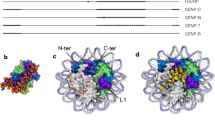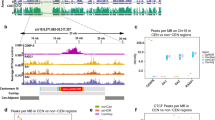Abstract
The localization of centromeres in mature human sperm was shown by immunofluorescent labeling and nonisotopic in situ hybridization. In the decondensed nucleus structural elements (dimers, tetramers, linear arrays and V shape structures) formed by individual centromeres of nonhomologous chromosomes were observed. They organize the compact chromocenter, which was shown for nuclei decondensed to a low extent. The chromocenter is buried inside the nucleus; in contrast, telomeric regions of chromosomes were tentatively localized on the periphery. Thus, a gross architecture, which can influence selective unpackaging of the paternal genome upon fertilization, exists in human sperm.
Similar content being viewed by others
References
Balczon RD, Brinkley BR (1990) The kinetochore and its roles during cell division. In: Adolph KW (ed) Chromosomes: Eukaryotic, prokaryotic and viral, vol 1. CRC Press, Boca Raton, Florida, pp 167–189
Bedford JM, Bent MJ, Calvin H (1973) Variations in the structure, character and stability of the nuclear chromatin in morphologically normal human spermatozoa. J Reprod Fertil 33:19–29
Breneman JW, Yau P, Teplitz RL, Bradbury EM (1993) A light microscope study of linker histone distribution in rat metaphase chromosomes and interphase nuclei. Exp Cell Res 206:16–26
Brinkley BR (1990) Towards a structural and molecular definition of the kinetochore Cell Motil Cytoskeleton 16:104–109
Brinkley BR, Brenner SL, Hall JM, Tousson A, Balczon RD, Valdivia MM (1986) Arrangement of kinetochores in mouse cells during meiosis and spermatogenesis. Chromosoma 94:309–317
Coonen E, Pieters MHEC, Dumoulin JCM, Meyer H, Evers JLH, Ramaekers FCS, Geraedts JPM (1991) Nonisotopic in situ hybridization as a method for nondisjunction studies in human spermatozoa. Mol Reprod Dev 28:18–22
Courtens J-L, Biggiogera M, Rothfield NF, Burnier M, Fakan S (1992) Migration of centromere proteins in rabbit spermatids. Mol Reprod Dev 32:369–377
Cox JW, Schenk EA, Olmsted JB (1983) Human anticentromere antibodies: distribution, characterization of antigens and effect on microtubule organization. Cell 35:331–339
Earnshaw WC (1991) When is a centromere not a kinetochore. J Cell Sci 99:1–4
Earnshaw WC, Rothfield N (1985) Identification of a family of human centromere proteins using autoimmune sera from patients with scleroderma. Chromosoma 91:313–321
Guldner HH, Lakomek H-J, Bautz FA (1984) Human anti-centromere sera recognise a 19.5 kD non-histone chromosomal protein from HeLa cells. Clin Exp Immunol 58:13–20
Gusse M, Sautierre P, Belaiche D, Martinage A, Roux C, Dadoune J-P, Chevaillier P (1986) Purification and characterization of nuclear basic proteins of human sperm. Biochim Biophys Acta 884:124–134
Haaf T, Grunenberg H, Schmid M (1990) Paired arrangements of nonhomologous centromeres during vertebrate spermatogenesis. Expt Cell Res 187:157–161
Hadlaczky GY, Went M, Ringertz NR (1986) Direct evidence for non-random localization of mammalian chromosomes in the interphase nucleus. Exp Cell Res 167:1–15
Jager S, Wijchman J, Kremer JJ (1990) Studies on decondensation of human, mouse and bull sperm nuclei by heparin and other polyanions. Exp Zool 256:315–322
Laemmli UK (1970) Cleavage of structural proteins during the assembly of the head of bacteriophage T4. Nature 226:680–685
del Mazo J, Kremer L, Avila J (1987) Centromeric proteins recognized by CREST sera and meiotic chromosome segregation. Chromosoma 96:55–59
Moens P, Pearlman RE (1989) Satellite DNA I in chromatin loops of rat pachytene chromosomes and in spermatids. Chromosoma 98:287–294
Palmer DK, O'Day K, Wener MH, Andrews BS, Margolis RL (1987) A 17-kD centromere protein (CENP-A) copurifies with nucleosome core particles and with histones. J Cell Biol 104:805–815
Palmer DK, O'Day K, Margolis RL (1990) The centromere specific histone CENP-A is selectively retained in discrete foci in mammalian sperm nuclei. Chromosoma 100:32–36
Paulson JR, Laemmli UK (1977) The structure of histone depleted metaphase chromosomes. Cell 12:817–828
Powell D, Cran DG, Jennings C, Jones R (1990) Spatial organization of repetitive DNA sequences in the bovine sperm nucleus. J Cell Sci 96:185–191
Reyes R, Rosado A, Hernandez O, Delgado NM (1989) Heparin and glutation: physiological decondensing agents of human sperm nuclei. Gamete Res 23:39–47
Schulman I, Bloom KS (1991) Centromeres: an integrated protein/DNA complex required for chromosome movement. Annu Rev Cell Biol 7:311–336
Sumner AT (1987) Immunofluorescent demonstration of kinetochores in human sperm. Exp Cell Res 171:250–253
Towbin H, Stahelin T, Gordon J (1979) Electrophoretic transfer of proteins from polyacrylamide gels to nitrocellulose filters. Proc Natl Acad Sci USA 76:4350–4354
Valdivia NM, Brinkley BR (1985) Fractionation and initial characterization of the kinetochore from mammalian metaphase chromosomes. J Cell Biol 101:1124–1134
Villepoteau B (1992) Heparin increases chromatin accessibility by binding to the trypsin sensitive basic residues in histones. Biochem J 288:953–958
Ward WS, Coffey DS (1991) DNA packaging and organization in mammalian spermatozoa: comparison with somatic cells. Biol Reprod 44:569–574
Wyrobek AJ, Alhborn T, Balhorn R, Stanker L, Pinkel D (1990) Fluorescence in situ hybridization to Y chromosomes in decondensed human sperm nuclei. Mol Reprod Dev 27:200–208
Zalensky AO, Yau P, Breneman JW, Bradbury EM (1993) The abundant 19-KDa protein associated with human sperm nuclei that is related to seminal plasma inhibins. Mol Reprod Dev, in press
Zinkowski RP, Meyne J, Brinkley BR (1991) The centromere-kinetochore complex: a repeated subunit model. J Cell Biol 113:1091–1110
Author information
Authors and Affiliations
Additional information
Communicated by: W.C. Earnshaw
Rights and permissions
About this article
Cite this article
Zalensky, A.O., Breneman, J.W., Zalenskaya, I.A. et al. Organization of centromeres in the decondensed nuclei of mature human sperm. Chromosoma 102, 509–518 (1993). https://doi.org/10.1007/BF00368344
Received:
Revised:
Accepted:
Issue Date:
DOI: https://doi.org/10.1007/BF00368344




